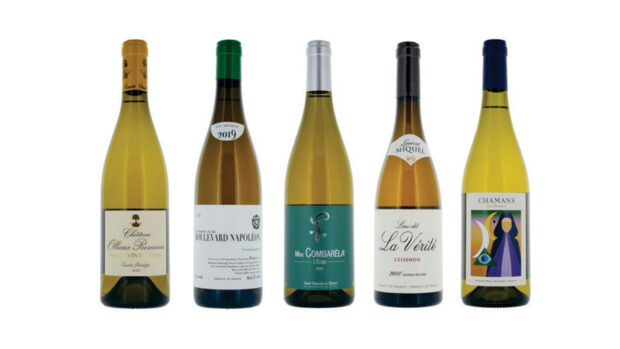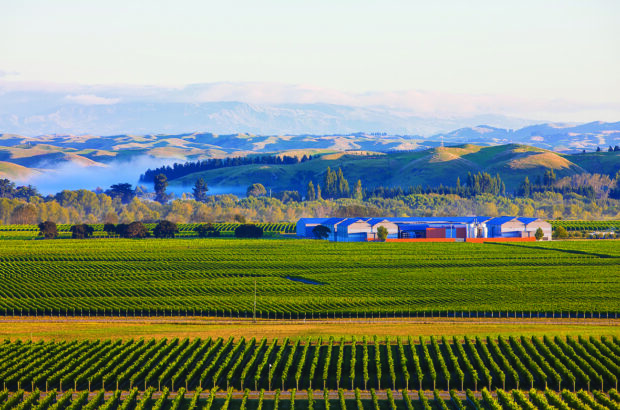The room hums with motorcycle memorabilia, vintage records, an oil-can guitar, and neon. Depeche Mode’s World in my Eyes pours from speakers. Jacey, a sales associate, decants into her giant Erlenmeyer flask a non-vintage red named I Had Too Much to Dream Last Night. She calls it an eight-grape, kitchen-sink blend. I catch hints of Barbera and Carignan and the reference to a 1966 Electric Prunes song. I ask more about it, but Jacey shrugs off my questions: ‘We don’t spend too much time talking about winemaking details.’ I understand. It’s garage rock… must we fuss over the time signature?
Tank Garage Winery, a rebel unicorn of Napa Valley, specialises in quaffable, ready-to-drink, affordable one-offs produced from contracted grapes at a warehouse in South Napa. Jacey says that South African-born winemaker Bertus van Zyl ‘spends time tasting stuff and saying we should do something cool with it – you may not remember what’s in the bottle, but you’ll remember the label’. Because here, and at other urban wineries around the US, it doesn’t matter what you’re drinking as long as you’re happy. As Tank puts it: ‘This weird little winery in Calistoga with cool labels and an affinity for the f-word… celebrates misfits, bootleggers and daredevils. No business plan, no exit strategy, just a mission to do cool shit.’ Far as I can tell, everyone’s having one helluva time.
Recall your last local brewery experience – a cross-town tube or Uber, live tunes, flip-flops, food trucks, curious tasting flights. Now copy and paste that whole scene, but with wine. Enter the downtown miracle-makers doing god’s work of crafting wine where there are no vines. Some aspire to heady, world-class stuff, but most aim simply to tickle our fancy. Urban wineries are casual, close-to-home, affordable, and they might just be wine’s 21st-century saviour.

Tank Garage Winery winemaker Bertus van Zyl. Credit: Rex Gelert Photography
Changing landscape
Wine-loving but ageing boomers are not being replaced by millennials. The growing young-consumer base doesn’t give primacy to wine. They date around: spirits, beer, spiked seltzer, cannabis. Plus, while they generally have a higher food and beverage IQ at their age than boomers did, they have less disposable income. They’ve embraced the liquor-is-quicker equation when it comes to oomph and cost per serving. Then there’s the whole low-alcohol, sober-curious thing – ‘Dry January’ certainly doesn’t refer to fino Sherry or brut rosé. It all adds up to fewer new people falling in love with wine.
According to Silicon Valley Bank’s State of the [US] Wine Industry Report 2020: ‘Baby boomers, who control 70% of US discretionary income and half of the net worth in the US, are moving into retirement and declining in both their numbers and per capita consumption, while millennials aren’t yet embracing wine consumption as many had predicted.’ They’re accustomed to tap rooms, loud labels, loud music and intermittent fasting. They start the night with a cocktail, order beer with dinner, keep a box of wine in their fridge, and maybe only drink on alternate weekends. The report’s author calls them ‘frugal hedonists’.
Combine this demographic change with an enormous grape and wine glut from prodigious recent vintages and we’re left with a seismic shift. Too much wine, too few oenophiles. Inexpensive yet high-quality fruit is increasingly available, along with easy transport from wine country to city centre. Technology allows clean, approachable wines to be made virtually anywhere and in any style. Urban wineries are the answer, blending the no-fuss accessibility of craft beer and the repackage-someone-else’s-work model of négociants with the cast- spells-in-a-cellar art of wine. It’s upcycling.
For too long, gatekeepers (critics, sommeliers, retailers) primed consumers to look to others to tell them what was good, while high costs of connoisseurship (travel, cases and verticals, temperature-controlled cellars) enhanced wine’s elitist reputation. Urban wineries eschew all of it: no ratings, hifalutin accoutrements (Coravin, anyone?) or wine country jet-setting. They’re sanctuaries for those who care less about clonal selection and more about social responsibility. ‘Millennials don’t trust the rich, are sceptical about inauthentic and opaque marketing, and don’t care about your family’s name on the bottle,’ explained the industry report. ‘They are more interested in… how you make the world better.’
What about terroir?
So many of us have been indoctrinated in the importance of terroir. Somewhereness is an oft-uttered term meant to represent those intangibles behind a wine’s authenticity and sense of place. No one’s saying we should forsake this idea, but the legion of urban wineries opening far, far away from any vineyards whatsoever are banking on a new term: somehowness. Somehow, urban wineries are thriving in places like Austin, Texas; Cleveland, Ohio; and Brooklyn, New York. Somehow, grape juice from the Rhône Valley is ending up in GSM blends vinified in Oklahoma. Somehow, a winemaker in North Carolina is making an unoaked Chardonnay sourced from Dry Creek Valley fruit.
Jason Lett, owner and winemaker at The Eyrie Vineyards in Willamette Valley, has a front-row seat to the urban winery movement, and is a fan. ‘In Oregon, most of the innovative young winemakers don’t have the capital to buy an estate, so they start in these awesome co-op spaces. As a result, the wines coming out of urban wineries are among the most exciting and thought-provoking from our area.’
Easy for Lett to say, when these garagistes are but a cork’s-throw from the choicest vineyards. There’s killer stuff coming from the nine-member PDX Urban Wineries Association in Portland, for instance. And the Lompoc Wine Ghetto is an enclave of 20 urban wineries in an industrial park against the backdrop of California’s Central Coast.
The farther you get from the source, though, the more the product and business models change. Grapes don’t travel well on a container ship. ‘In general, the ones that do better are located nearer wine-producing areas,’ says master sommelier Robert Jones. ‘Are you buying grapes and selling wine made on the premises? Or are you simply buying juice, blending and bottling it. I don’t want to visit an urban ‘blendery’. I think these are businesses that just happen to be wineries.’
After tasting through some 60 bottles from urban wineries, I posted a panorama of them on social media. Said a fifty-something friend: ‘Is it just me or has wine label design gone off a damn cliff? #oldschool.’ Said a millennial friend: ‘I really wish those were mail-able.’ Where you find yourself in this debate likely determines how much you’ll like what’s inside the bottle.
There are wine-first operations, but, for others, the whole thing is a social scene or an event space, or a community hub, or a clever commercial enterprise for whom wine is but a shiny MacGuffin: the briefcase in Pulp Fiction that drives action but doesn’t really matter.
Community spirit
One great example is The Infinite Monkey Theorem Urban Winery. In both of its locations (Austin, Texas and Denver, Colorado), the winery space, vibe and hospitality are so welcoming/fun/cool, that your drink is secondary to your experience. But the wine has its own story, too. Each IMT location sources fruit predominantly from local vineyards and a lot of it ends up as canned wine, unsurprisingly given that both cities are huge beer hubs. ‘The wines are not only expressions of the local fruit, the process, and the personality of the winemaker, but also of the people drinking the wine,’ reads IMT’s mission statement. ‘It is a product born out of the community and thus representative of the community.’
Lindsey Williams is the lawyer-turned-winemaker owner of North Carolina’s Davidson Wine Co, a 30-minute drive from downtown Charlotte. ‘I never lived anywhere with a great wine region. I grew up in Ohio,’ she says. ‘I love to travel to Napa, but it’s nice to have a similar experience in your own town.’ Williams is a black business owner who sees a bigger picture. She hosts comedy nights, book clubs, yoga, knitting and hands-on winemaking classes. ‘Some people feel intimidated by going into a winery. Introducing wine in a different way – fostering a community that wouldn’t exist otherwise – is always a good thing.’ She’s already looking at more real estate south of the city. ‘This model lends itself to expansion while maintaining local connection.’
Davidson Wine Co falls under the umbrella of Waters Edge Wineries, a franchise that streamlines and systemises everything you need to run your own outfit. ‘Roughly 80% of the wineries in the US are in five states,’ says company founder Ken Lineberger. ‘That’s just wrong. It’s a complete imbalance in the supply chain.’ In 2012, he and his wife rolled out a model whereby people like Williams could be handed a playbook for opening an urban winery anywhere. ‘A way to do it better, more efficiently, and be in business for yourself but not by yourself.’ Franchisees (currently 18 locations in 10 states) are trained to follow a process that starts en masse – bulk juice preserved with a French technique called flash détente thermovinification. Grape must arrives separated from skins. Winemakers at each location control skin contact, blending, barrel ageing, bottling and labelling. Says Lineberger: ‘People like to experience the local bakery; we want to leverage that with wine made locally.’
Destiny Burns, owner/founder of CLE urban winery, aims for ‘good wine made fun that celebrates Cleveland’. She says: ‘Community is essential to what we do. It’s almost a bigger part of why I did this than my love for wine – bringing something new to my hometown for a diverse group of people to get together and not be intimidated.’ Burns has local grapes available, but instead contracts with Kendall Farms, a grape-broker in Washington. ‘We get our custom crush in 275-gallon [1,041-litre] reusable polyethylene totes on a refrigerated truck and it’s in Cleveland three days later. Can’t get any fresher than that unless I had vineyards myself.’ She’s purchased Ohio grapes before, but typically doesn’t, ‘because we get better quality at a better price from the West Coast, and that’s just the honest truth’.
During Covid, Burns packaged Rust Belt Rosé Slushies and Buckeye Blackberry Merlot Freezy Pops for take-out. Leaning-in efforts like these earned her Les Dames d’Escoffier International’s 2020 Wine & Hospitality Award.
Exciting prospects
Somehow, even during this world-halting madness, Tank Garage Winery has continued to send poems, online quizzes, and regular emails with nary a mention of bâtonnage, Brix or bud-break. Somehow, none of that feels important right now. The last thing I ask Jacey before I leave is, ‘What’s next?’ Again she shrugs. ‘We don’t know, but we promise it won’t be boring.’ She’s talking about Tank, but the same could be said for Davidson, IMT and CLE. Somehow, I know she’s right.
Urban wineries: the London scene
It’s not just a US phenomenon – urban wineries have sprung up in cities across the globe, and London today is home to four urban wineries. Renegade Urban Winery and Bar is in east London, and there are three in southwest London: London Cru Winery (associated with Roberson Wine), Vagabond Urban Winery (with Vagabond Wines), and Blackbook Winery. All four organise regular tastings and events.












